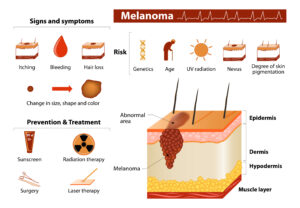Melanoma occurs when something goes wrong in the DNA of a melanocyte, which is the cell in our skin that gives it color. Occasionally, melanoma can occur in the eye or throat. Fortunately, it is not as common as other skin cancers, basal cell or squamous cell, but has a far greater propensity to spread or metastasize. The etiology of melanoma is not well understood but it has a predilection for areas of the skin that are exposed to sunlight, such as the face, neck, back, chest, arms and legs. In people of color, it can occur on the palmar surface of the hands, between the toes and under the nailbeds. Often the first signs of a melanoma are changes in the size, shape or color of a mole. Normal moles are round, uniform in color and usually the size of a pencil head eraser (4mm) or smaller.
not as common as other skin cancers, basal cell or squamous cell, but has a far greater propensity to spread or metastasize. The etiology of melanoma is not well understood but it has a predilection for areas of the skin that are exposed to sunlight, such as the face, neck, back, chest, arms and legs. In people of color, it can occur on the palmar surface of the hands, between the toes and under the nailbeds. Often the first signs of a melanoma are changes in the size, shape or color of a mole. Normal moles are round, uniform in color and usually the size of a pencil head eraser (4mm) or smaller.
To help screen yourself for melanoma use the of the letters A, B, C, D and E where A is for asymmetry. One half of the mole looks different from the other half. B is for irregular borders where one border is notched or scalloped. C is for more than one color. Normal moles are uniform in color. D is for an enlarging diameter (greater than 6 mm), and E is for evolving, such as a mole changing in shape, size, color or beginning to itch or bleed.
The best prevention advice is to avoid the sun between 10 AM and 4 PM when the UV radiation is worse. Wear sunscreen that is a SPF of 30 or more, wear protective clothing, avoid tanning beds and have your doctor check your skin yearly.
Regular skin cancer screenings aid in early detection and can be completed right here at Wickenburg Community Hospital Surgical Clinic; 519 Rose Lane. Get your skin cancer screening today by calling Dr. Robert Ripley at 928-668-5506.


